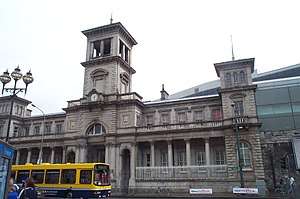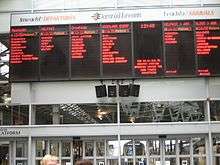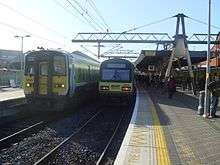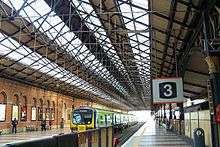Connolly station
Connolly station (Irish: Stáisiún Uí Chonghaile) or Dublin Connolly is the busiest railway station in Dublin and Ireland, and is a focal point in the Irish route network. On the North side of the River Liffey, it provides InterCity, Enterprise and commuter services to the north, north-west, south-east and south-west. The North-South Dublin Area Rapid Transit (DART) and Luas light rail services also pass through the station. The station offices are the headquarters of Irish Rail, Iarnród Éireann. Opened in 1844 as Dublin Station, the ornate facade has a distinctive Italianate tower at its centre.
 The façade of the station, 2006 | ||||||||||||||||||||||||||||||||||||||||||||||||||||||||||||||||||||||||||
| Location | Amiens Street, Dublin 1, D01 V6V6 Republic of Ireland | |||||||||||||||||||||||||||||||||||||||||||||||||||||||||||||||||||||||||
| Coordinates | 53.351210°N 6.250185°W | |||||||||||||||||||||||||||||||||||||||||||||||||||||||||||||||||||||||||
| Owned by | Iarnród Éireann | |||||||||||||||||||||||||||||||||||||||||||||||||||||||||||||||||||||||||
| Operated by | Iarnród Éireann | |||||||||||||||||||||||||||||||||||||||||||||||||||||||||||||||||||||||||
| Platforms | 9 (including 2 for Luas) | |||||||||||||||||||||||||||||||||||||||||||||||||||||||||||||||||||||||||
| Bus routes | 90 | |||||||||||||||||||||||||||||||||||||||||||||||||||||||||||||||||||||||||
| Bus operators | Dublin Bus | |||||||||||||||||||||||||||||||||||||||||||||||||||||||||||||||||||||||||
| Construction | ||||||||||||||||||||||||||||||||||||||||||||||||||||||||||||||||||||||||||
| Structure type | Elevated | |||||||||||||||||||||||||||||||||||||||||||||||||||||||||||||||||||||||||
| Other information | ||||||||||||||||||||||||||||||||||||||||||||||||||||||||||||||||||||||||||
| Station code | CNLLY | |||||||||||||||||||||||||||||||||||||||||||||||||||||||||||||||||||||||||
| Fare zone | Suburban 1 | |||||||||||||||||||||||||||||||||||||||||||||||||||||||||||||||||||||||||
| History | ||||||||||||||||||||||||||||||||||||||||||||||||||||||||||||||||||||||||||
| Opened | 29 November 1844 | |||||||||||||||||||||||||||||||||||||||||||||||||||||||||||||||||||||||||
| Key dates | ||||||||||||||||||||||||||||||||||||||||||||||||||||||||||||||||||||||||||
| 1844 | Opened as Dublin Station | |||||||||||||||||||||||||||||||||||||||||||||||||||||||||||||||||||||||||
| 1854 | Renamed Amiens Street Station | |||||||||||||||||||||||||||||||||||||||||||||||||||||||||||||||||||||||||
| 1966 | Renamed Connolly Station after James Connolly on the 50th anniversary of the 1916 Easter Rising | |||||||||||||||||||||||||||||||||||||||||||||||||||||||||||||||||||||||||
| 1983 | Station upgraded | |||||||||||||||||||||||||||||||||||||||||||||||||||||||||||||||||||||||||
| 1999 | Station refurbished and partially rebuilt | |||||||||||||||||||||||||||||||||||||||||||||||||||||||||||||||||||||||||
| ||||||||||||||||||||||||||||||||||||||||||||||||||||||||||||||||||||||||||



Services
Connolly has seven platforms; four terminal (1-4) and three through - the former Amiens Street Junction station - (5-7). The ticket office is open from 06:30 hrs to 19:00 hrs, Monday to Sunday. The station also features a depot for the Commuter, the InterCity and the Enterprise.
InterCity
There are three InterCity routes served:
- The Enterprise service to Belfast Central (intermediate stops, Drogheda, Dundalk, Newry, Portadown and Lisburn)
- Sligo Mac Diarmada non-stop to Maynooth and calling at all stations to Sligo. Peak services call at Drumcondra.
- Rosslare Europort, calling at Tara Street, Dublin Pearse, Dun Laoghaire, Bray, Greystones and all stations to Rosslare Europort. Not all services call at Kilcoole. Peak services call at Blackrock, Lansdowne Road and Grand Canal Dock. The 16:33 departure from Connolly to Rosslare Europort offers a connection to ferries for Wales and France.
DART
DART use platforms equipped with overhead wires (Platforms 5, 6, and 7). Terminal Platform 4 is also electrified. As of January 2019 there are 6 DARTs per hour in each direction on weekdays. These are:
- Northbound: 3 per hour to Howth and 3 per hour to Malahide
- Southbound: 4 per hour to Bray and 2 per hour to Greystones
After years of delays, Irish Rail increased the DART frequency to every ten minutes in September 2018 which increased the number of trains per hour in Howth and Malahide to 3 and those terminating at Bray to 4 per hour but kept Greystones at 2 per hour, with some peak services also terminating at Dún Laoghaire. It is also planned to expand the DART lines to Maynooth, Hazelhatch and Balbriggan or Drogheda.[1]
Commuter
Some Commuter services run along the DART line as far as Malahide. There are 2 Commuter services per hour in each direction off peak. These are:
- Maynooth from platforms 6 or 7: Calling at all stations to Maynooth.
- Drogheda/Dundalk from platform 6 or 7: Calling at Malahide and all stations to Drogheda/Dundalk, with some services also calling at Howth Junction, Clongriffin and Portmarnock.
2 trains per hour to Dublin Pearse from platform 5 or 6.
Peak time services also run to Longford, Hazelhatch, Newbridge, Newry, Dundalk, Balbriggan, Grand Canal Dock and Bray. There are also 3 trains per day from M3 Parkway to Connolly but do not run the return journey.
Statistics
| Year | Daily Passenger Exit and Entry | Change[2] |
|---|---|---|
| 2012 | 27,605 | NA |
| 2013 | 25,823 | |
| 2014 | 24,960 | |
| 2015 | 28,506 | |
| 2016 | 30,966 |
History
The station opened on 29 November 1844[3] by the Dublin and Drogheda Railway Company as Dublin Station, but was renamed Amiens Street Station ten years later after the street on which it is located. Originally the station served only a single mainline to Drogheda, and in 1853 through services to Belfast commenced. In 1891, the City of Dublin Junction Railway connected the station with Westland Row Station (now Pearse Station) on the city's South side. The City of Dublin Junction had a separate station known as Amiens Street Junction consisting of the present platforms 5, 6, and 7 (currently used by DART, Commuter and Rosslare services) with a separate street entrance. After the amalgamation of the GNR (I) at the end of the 1950s, this station became part of Amiens Street and the separate entrance fell into disuse. The City of Dublin Junction Railway allowed services to run from Amiens Street through to Westland Row to Rosslare and the South East. Services to Sligo were transferred to Westland Row (Pearse Station) running non-stop through the station in 1937, with the closure of Broadstone Station by CIÉ (see also MGWR). Services to Galway and Mayo also terminated at Westland Row, operating through Connolly Station after 1937, running via Mullingar and Athlone. This was discontinued in the 1970s in favour of running services from Heuston Station. Sunday trains to Cork, Limerick and Waterford during the 1960s operated from Connolly platforms 5, 6 and 7 through the Phoenix Park Tunnel, so as to avoid the cost of opening Heuston for the limited Sunday traffic demand at that time.
In 1966, the 50th anniversary of the Easter Rising, the station's name was changed to Connolly Station after Irish revolutionary and socialist James Connolly. At the same time, other main stations were renamed after patriots executed for their roles in the Rising.
At the commencement of DART services in 1984, the City of Dublin Junction Railway entrance was refurbished and reopened for commuters.
During the late 1990s, Connolly Station was completely renovated and partially rebuilt. An entirely new station hall was built, the roof over platforms 1 to 4 was replaced, and a new bar/café and shops were installed. The former DART/Suburban station entrance (City of Dublin Junction Railway entrance) and the secondary station hall built with the DART (further north on Amiens Street) were again closed, but a new entrance on the International Financial Services Centre side was opened. The Luas Red Line began serving the station in 2004. As part of the preparation for this, the ramp that had been a bus terminus was demolished and replaced with a two-platform tram station connected to the main concourse by escalators and lift.
Docklands railway station
The opening of Docklands Station in March 2007 has provided an extra terminus station to take pressure from Connolly. During Monday to Friday peak times, trains from M3 Parkway and Dunboyne arrive at Docklands. It also provides an alternative terminus for the Western Commuter line to Mullingar if needed.
Docklands is the planned terminus for services to Navan.
As part of the DART Underground, Docklands will be replaced or supplemented by a new underground Spencer Dock station; this will further increase capacity in Connolly Station.
City Centre Resignalling Project
According to Iarnród Éireann, the project has provided the ability to operate 20 trains per hour in both directions through the Howth Junction to Grand Canal Dock line, which caters for Howth DARTs, Malahide DARTs, Northern Commuter trains, Belfast Enterprise services, Sligo InterCity, Western and South Western Commuter services, as well as other services in the Connolly to Grand Canal Dock area.[4] This means that more trains travel through Connolly rather than terminating; it has also facilitated the use of the Phoenix Park rail tunnel for commuter rail connections.[5] The project began in March 2015 and was commissioned on 17 July 2016.
Future
Connolly Station Area Redevelopment
This project will involve redeveloping the east section of the Connolly station area "to provide 81,500 sq. m. of mixed commercial, residential community and leisure uses comprising 50,200 sq. m. of office accommodation; 106 apartments; a hotel; retail and restaurants and a crèche." [6]
In April 2012, CIÉ received planning approval from Dublin city Council for the redevelopment.[7] In September 2017, CIÉ announced it was seeking a partner to develop Connolly Station site. [8] In 2018, CIÉ appointed Oxley Holdings as its partner for the construction of 697 build-to-rent apartments on Sheriff Street Lower. Planning permission was lodged in April 2019.[9]
Connections
While Connolly mainly connects Dublin to the East Coast of Ireland and to Sligo, Dublin Heuston serves the South and West of the country. Connolly Station is connected to Heuston via the Luas tram. Rail links connect the two stations passing through a tunnel under the Phoenix Park. Since 21 November 2016, passenger services regularly use it. Up until then, its main purpose was the transfer of rolling stock and locomotives (the main service depot is at Inchicore, just outside Heuston).[5]
Rail and ferry connections at Dublin Port
The station is connected by bus to Dublin Port with Stena Line ferries from the Ferry Terminal to Holyhead, with connecting trains along the North Wales Coast Line to Bangor, Llandudno Junction, Colwyn Bay, Rhyl, Prestatyn, Chester, Crewe and stations to London Euston. SailRail is promoted as a viable alternative to air transport by using trains and ferries to reach places across the Irish Sea.[10]
Holyhead can also be reached by Irish Ferries or Stena Line from Dublin Port, reached by walking beside the tram lines around the corner from Amiens Street, Dublin into Store Street or by Luas one stop to Busáras where Dublin Bus operates a service to the Ferry Terminal, or Dublin Bus route 53 [11] or to take a taxi.
Former ferry and DART connection at Dún Laoghaire
The ferry service from Dún Laoghaire was discontinued indefinitely in September 2014. Passengers traveled on the DART to Dún Laoghaire to sail using the Stena Line service. Now the route is a bus via Dublin Port to Holyhead as above.
Rail and ferry connections at Rosslare Europort
InterCity trains from Connolly to Rosslare Europort connect with the evening ferry to Fishguard Harbour with through ticketing to places including Carmarthen, Llanelli and Swansea.[10][12]
Irish Ferries and Stena Line operate ferries from Rosslare Europort to Cherbourg in France. There is also a seasonal route to Roscoff operated by Irish Ferries.[13][14]
Gallery
 The front of the main concourse in 2007
The front of the main concourse in 2007.jpg) Terminus platforms 1 to 4 in 2004
Terminus platforms 1 to 4 in 2004.jpg) NIR Locomotive with an Enterprise service to Belfast Central
NIR Locomotive with an Enterprise service to Belfast Central Luas tram terminus at station entrance in 2005
Luas tram terminus at station entrance in 2005
References
- Rail, Irish. "DART Expansion Programme". Irish Rail. Retrieved 22 December 2019.
- "Archived copy" (PDF). Archived from the original (PDF) on 29 October 2017. Retrieved 29 October 2017.CS1 maint: archived copy as title (link)
- "Dublin Amiens Street" (PDF). Railscot - Irish Railways. Retrieved 31 August 2007.
- "City Centre Resignalling Project". Irishrail.ie. Archived from the original on 17 December 2014. Retrieved 16 April 2015.
- "Plans for four trains an hour in Phoenix Park tunnel next year". The Herald. 9 March 2015. Retrieved 18 March 2015.
- "Connolly Station Dublin 1IMG Planning | IMG Planning". Imgplanning.ie. Retrieved 16 April 2015.
- Cormac Murphy (17 April 2012). "Vision to improve Connolly Station given the go-ahead". Herald.ie. Retrieved 16 April 2015.
- Comiskey, Justin. "CIÉ seeks partner to develop Connolly Station site". The Irish Times.
- Deegan, Gordon. "Ronan plans €350m residential development for Docklands". The Irish Times.
- "SailRail". Irishrail.ie. Archived from the original on 8 February 2014. Retrieved 16 April 2015.
- "53 - Dublin Bus". Dublinbus.ie. 22 April 2012. Retrieved 16 April 2015.
- "Rosslare to Fishguard". Stenaline.ie. Archived from the original on 3 December 2013. Retrieved 28 May 2012.
- "Ferry To France From Ireland | Cheap Ferry To France". Irishferries.com. 21 January 2013. Archived from the original on 15 May 2013. Retrieved 16 April 2015.
- "Ferry to Britain, France & Rest of Europe - Stena Line". Celticlinkferries.com. Retrieved 16 April 2015.
Bibliography
- Johnson, S. (1997). Johnson's Atlas & Gazetteer of the Railways of Ireland, Midland Publishing Ltd. ISBN 1-85780-044-3.
- O'Connor, K. (1999). The Great Northern Railway in Ironing the Land, The Coming of the Railways to Ireland, pp. 23–45. Gill & Macmillan Ltd. ISBN 0-7171-2747-8. (see also RTÉ TV series of same title)
External links
| Wikimedia Commons has media related to Dublin Connolly railway station. |